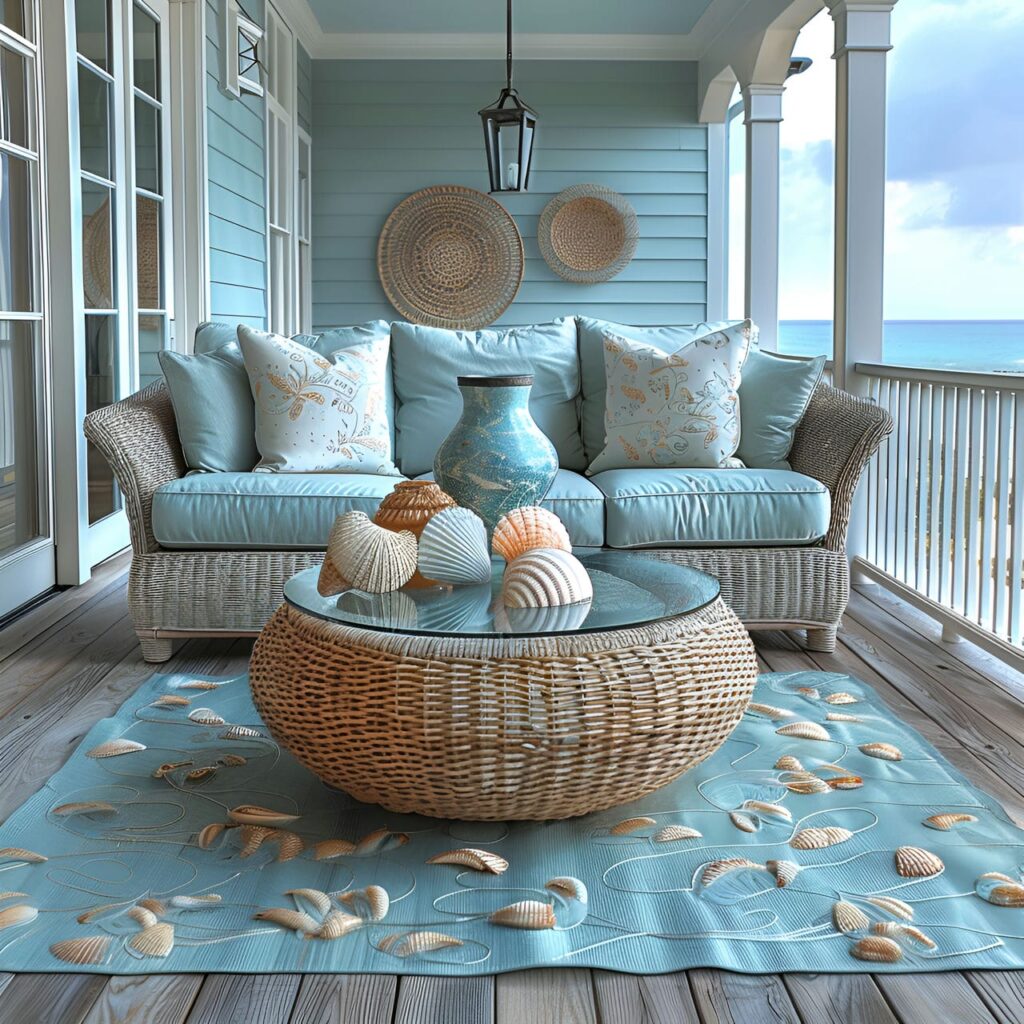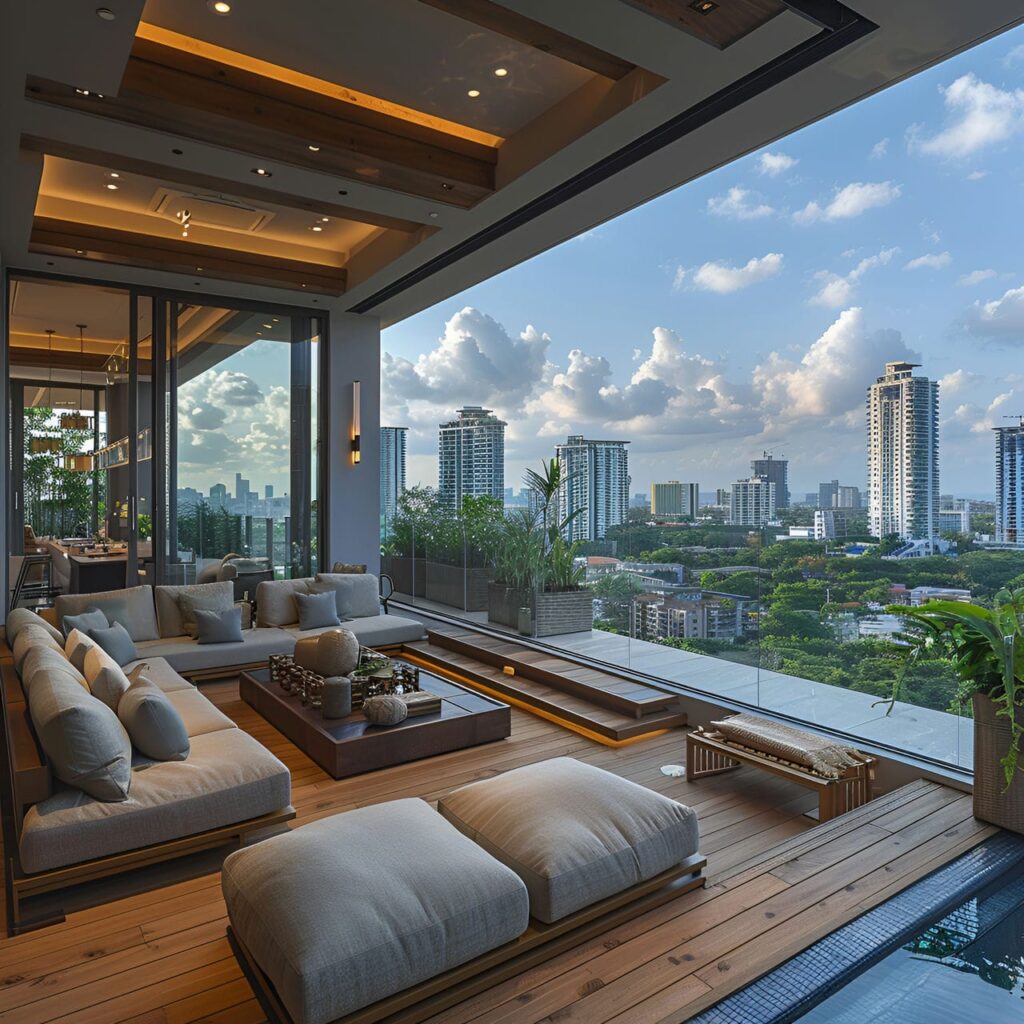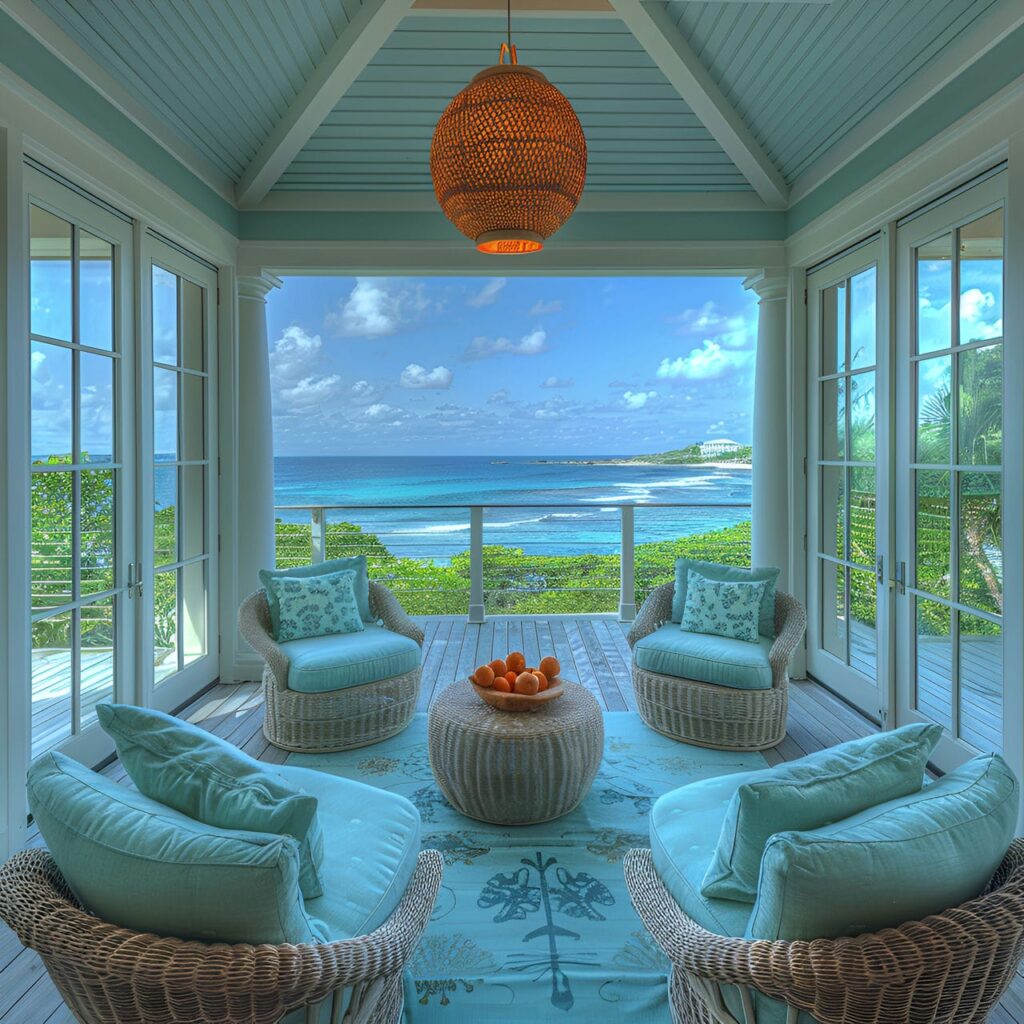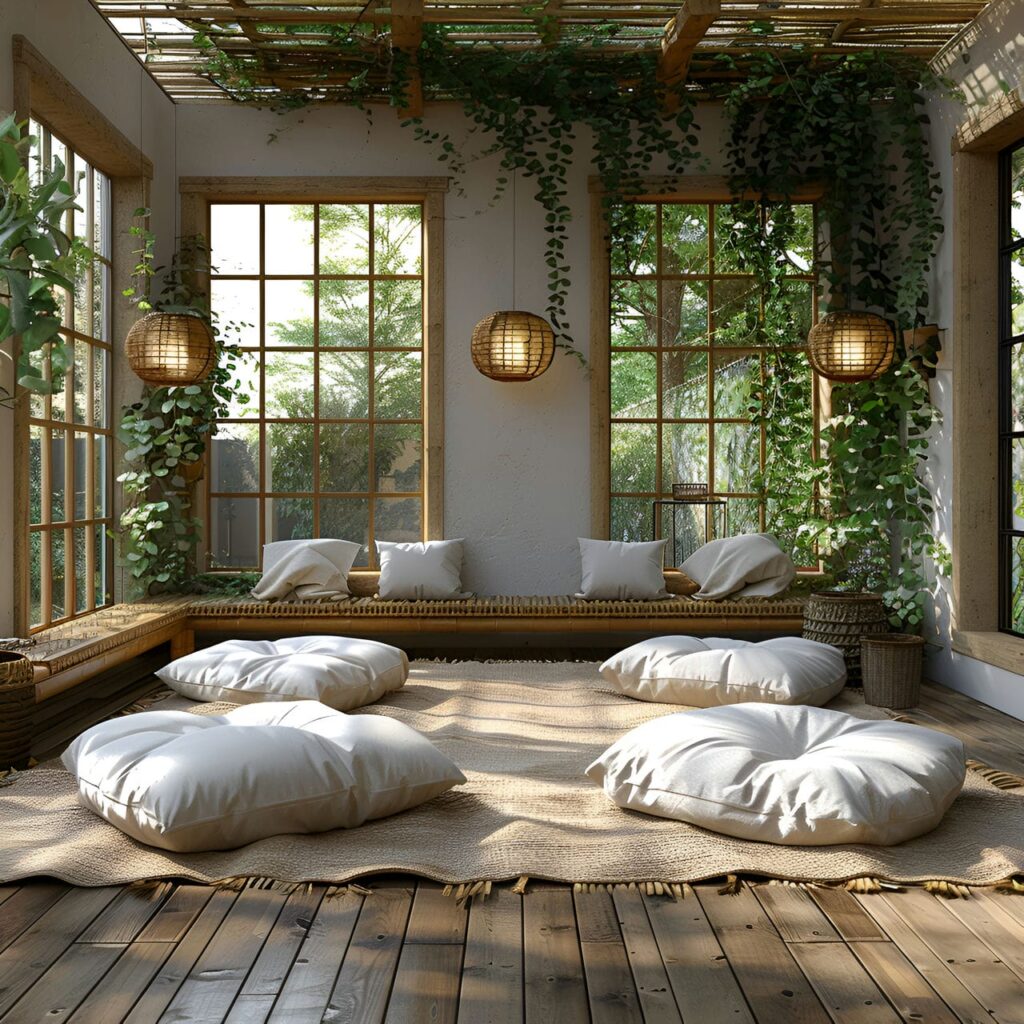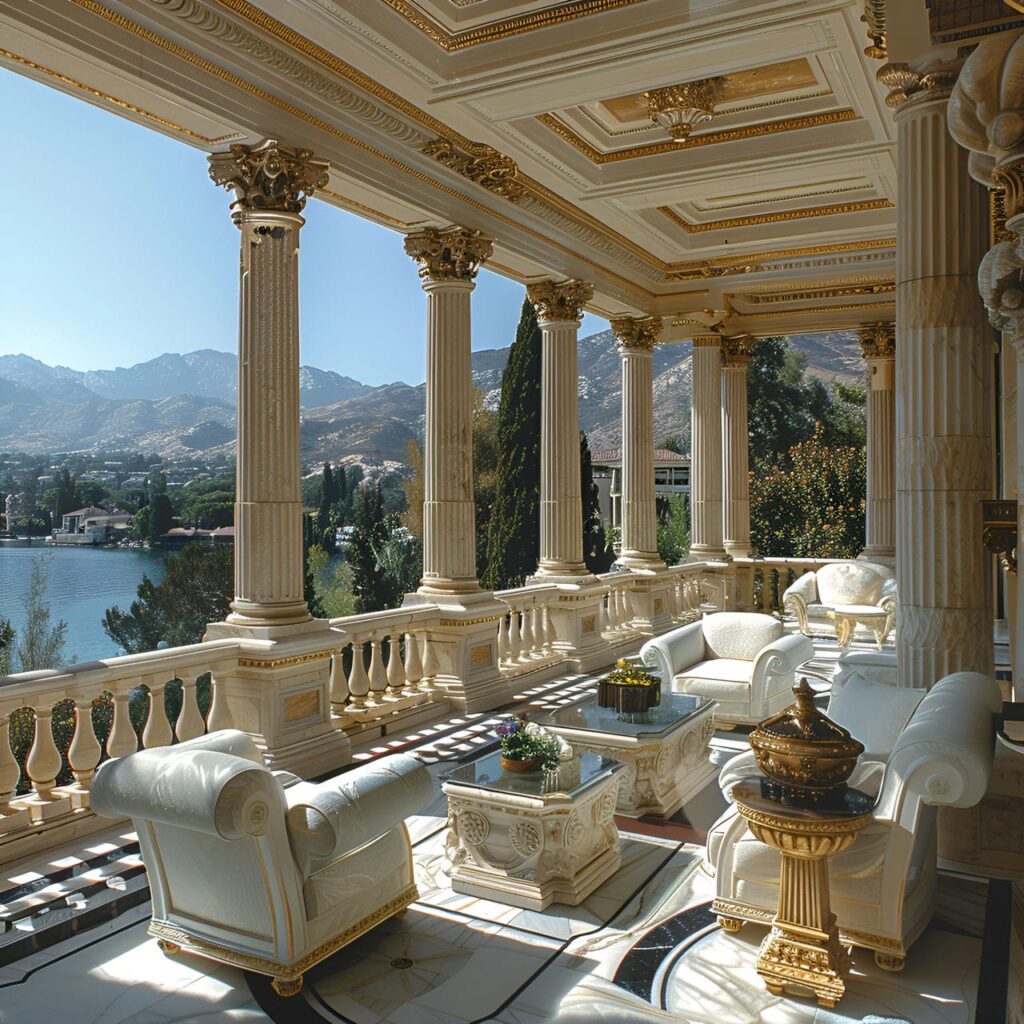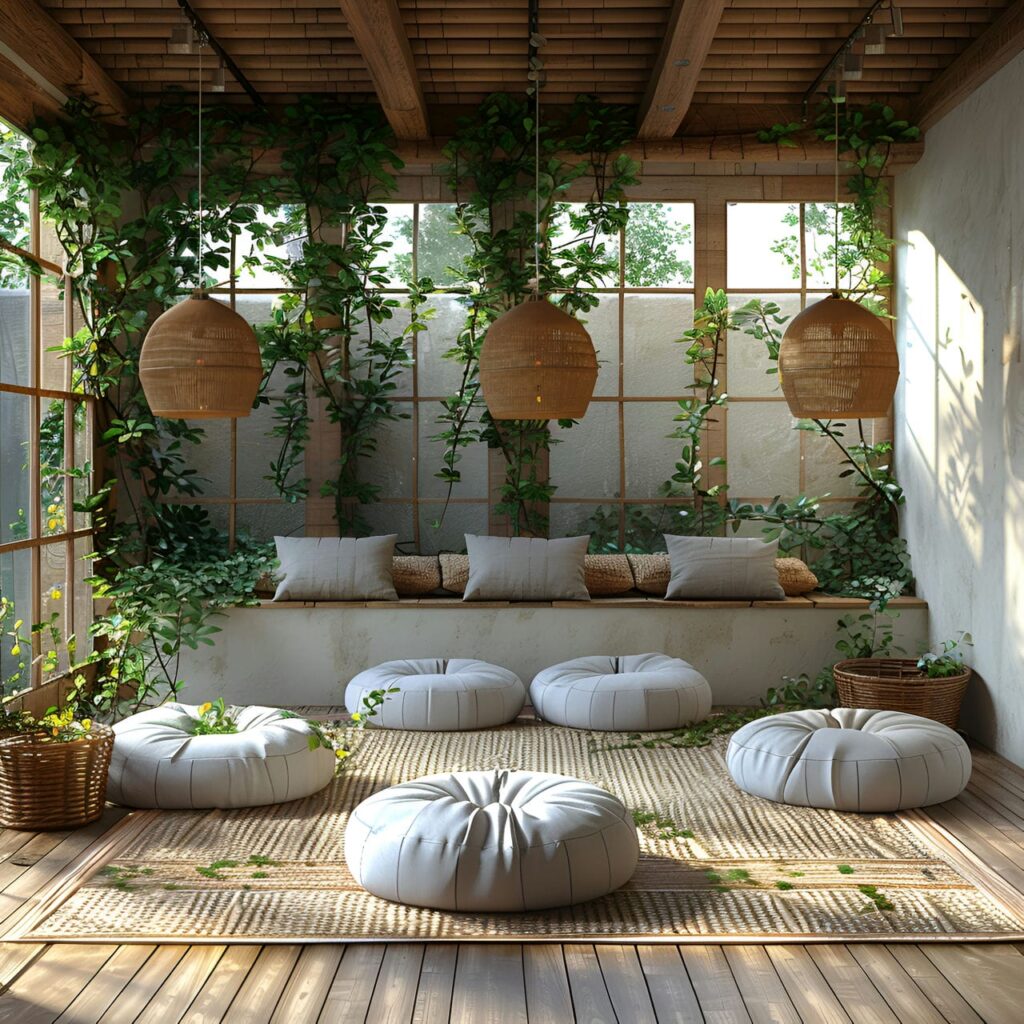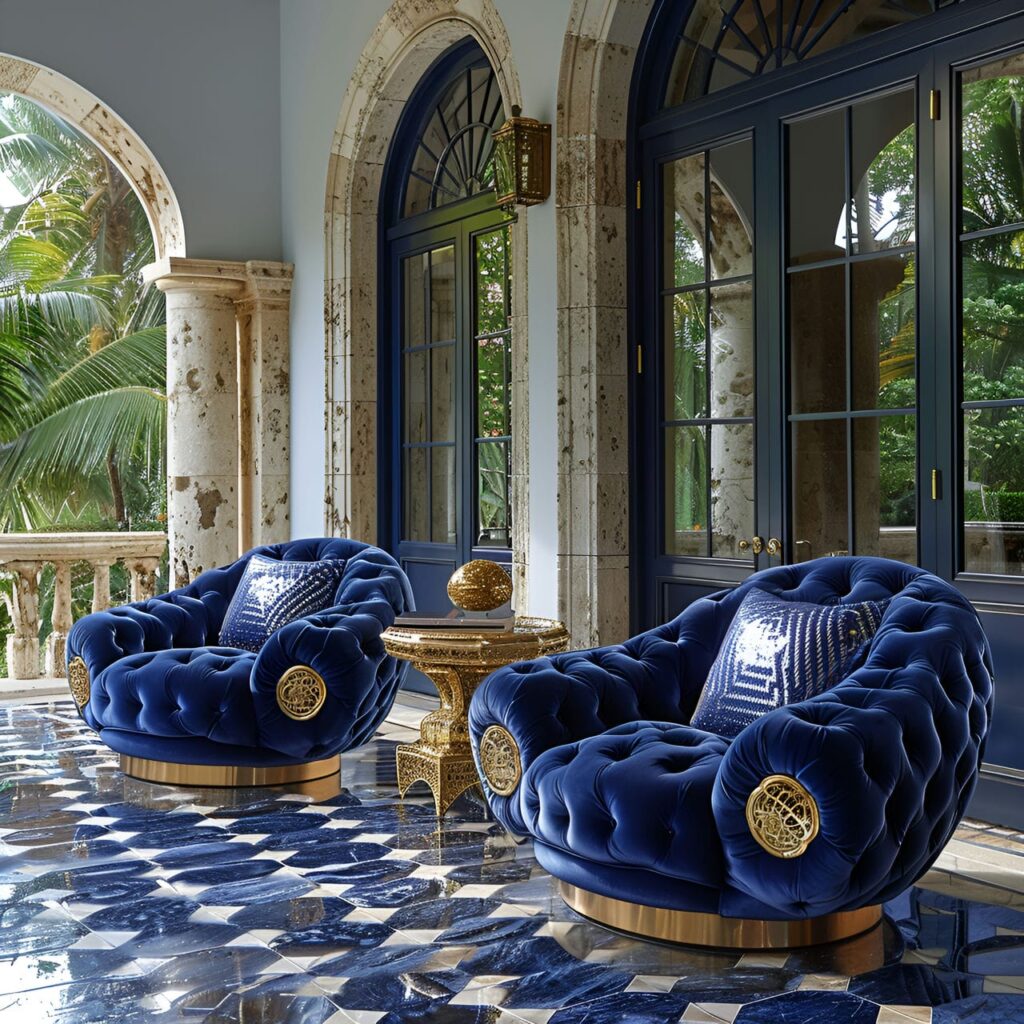A lanai, typically measuring 130 to 170 square feet (12 to 16 square meters), serves as an outdoor living area, extending indoor comfort. Commonly rectangular or square, it accommodates patio furniture, dining sets, and relaxation features. Popular lanai colors include blue, white, green, beige, yellow, coral, and gray, reflecting natural elements and creating a pleasant ambiance. Lanais are functional due to their weather protection, flexibility in usage, and scenic views. Renovating a lanai involves size, layout, materials, design preferences, location, climate, privacy, functionality, and budget. Hiring an architect, while not mandatory, is advisable for optimal design and integration with the home. Redecorating a lanai can take 2 to 6 weeks, influenced by size, renovation extent, material availability, contractor schedules, and unforeseen challenges. Homeowners need help with budgeting, material selection, design decisions, weather considerations, space optimization, contractor coordination, and regulatory compliance. Despite challenges, the benefits of a well-designed lanai, including increased living space, aesthetic appeal, and potential property value enhancement, make it a worthwhile investment.
What is the typical size of a lanai?
A typical residential lanai ranges from 130 to 170 square feet (12 to 16 square meters). This allows fitting essential patio furniture like a dining table set, lounge chairs, and a standalone bar/grilling station. A standard home ceiling height of 8 feet (2.4 meters) works well. The 130 to 170-square-foot footprint comfortably creates an intimate outdoor entertaining space for 2-4 people. The average lanai measures 170 to 260 square feet (16 to 24 square meters), better accommodating more extensive furnishings. Ceiling height often matches indoor spaces at 8 feet (2.4 meters) by extending eave lines for weather coverage. The average lanai incorporates lightweight tables and chair sets, accent cabinets with cushions, fire features, and hot tubs arranged conveniently without congestion across the tile or deck floors.
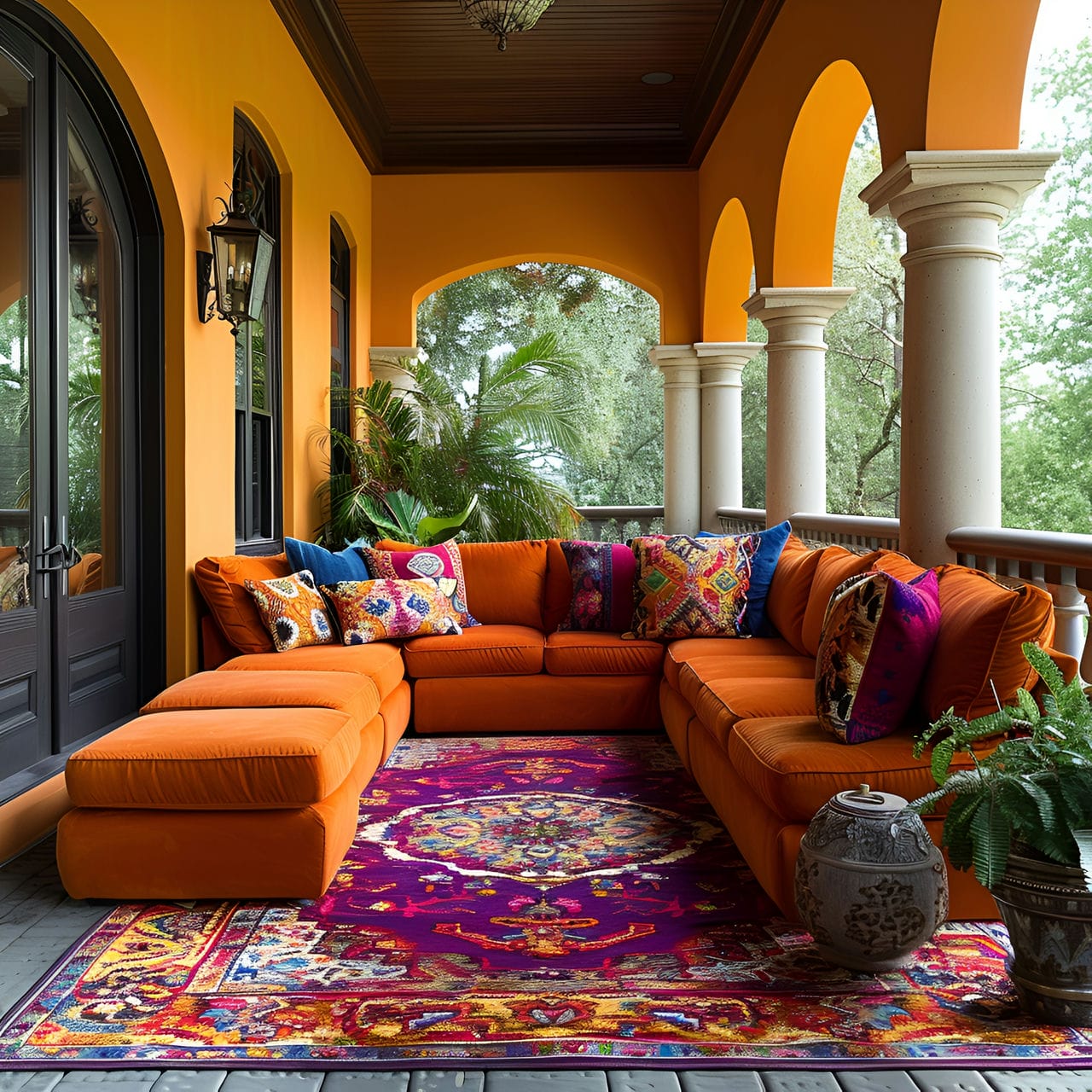
Grand lanais in luxury estates open to expansive spaces exceeding 375 square feet (35 square meters), spanning 645 square feet (60 square meters) or more. Soaring custom ceiling structures allow the incorporation of hanging beds, vertical gardens, rain curtains, or aperture roofs to control sunlight/climate. Spacious layouts incorporate substantial conversation areas, outdoor kitchens, weatherproof televisions, and specialty landscaping across horizontal and vertical spaces.
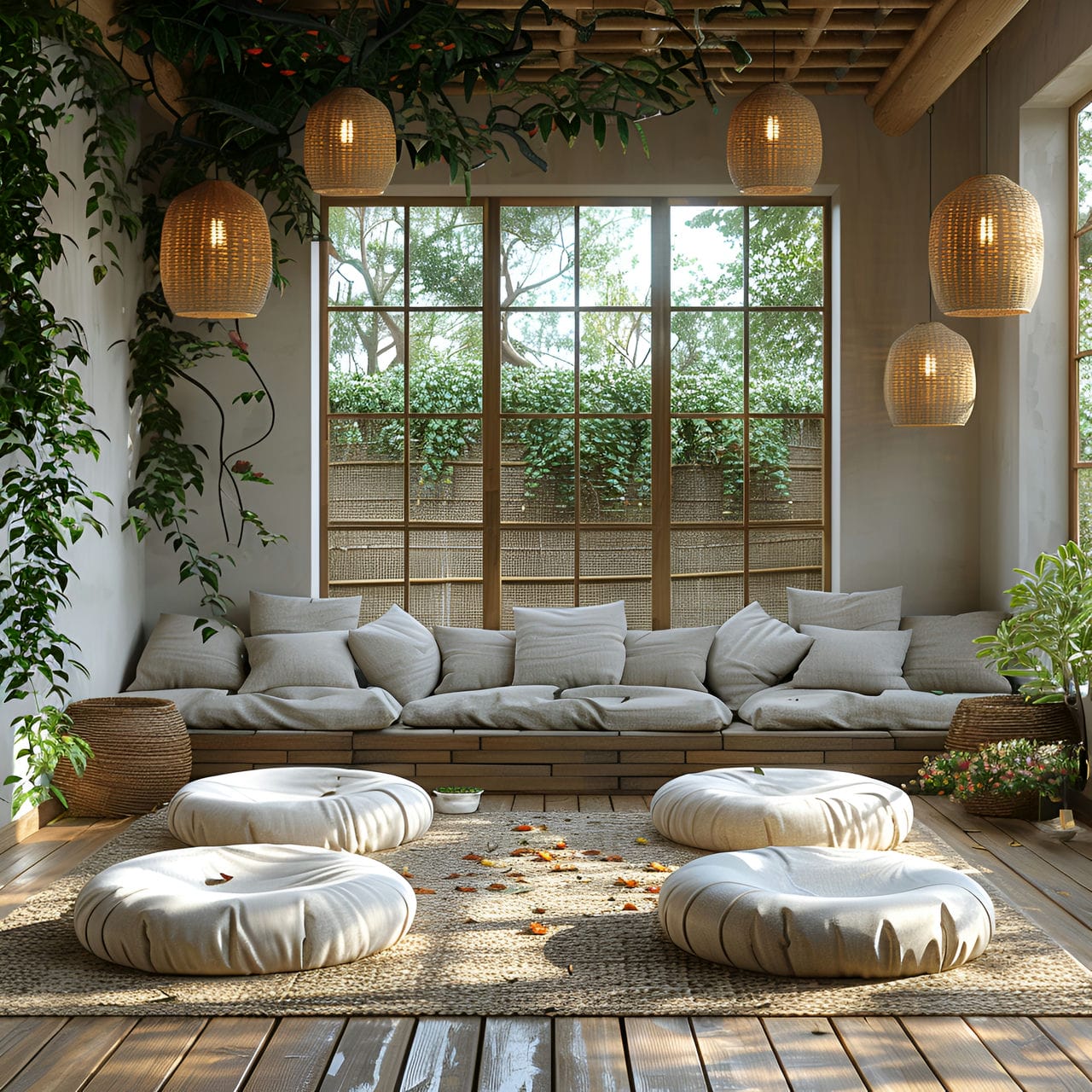
What is the use and purpose of a lanai?
The purpose of a lanai is to provide a weather-protected outdoor living area that extends the indoor space, functions, and comforts outside the home for relaxation, activities, and entertaining. Firstly, a lanai is an outdoor living space that extends the home. It provides extra room for relaxing, entertaining guests, dining, or other activities while allowing occupants to enjoy the fresh air and the outdoors. Secondly, a lanai offers weather protection and temperature regulation. The roof shields the interior from sun, rain, and other elements, while the open-air design prevents overheating. This makes the lanai comfortable to use in warm climates. Thirdly, a lanai adds flexibility and versatility to the home. It can be furnished with seating, tables, outdoor kitchens, televisions, and more to accommodate different functions. Fourthly, a lanai reasonably increases a home’s usable square footage. Adding a complete sunroom can be costly, but a lanai provides protected outdoor space for a lower investment. Lastly, a lanai provides a pleasing outdoor room addition that suits many architectural styles. Wooden features can give a rustic touch, while the transparency of screens makes the surroundings visible.
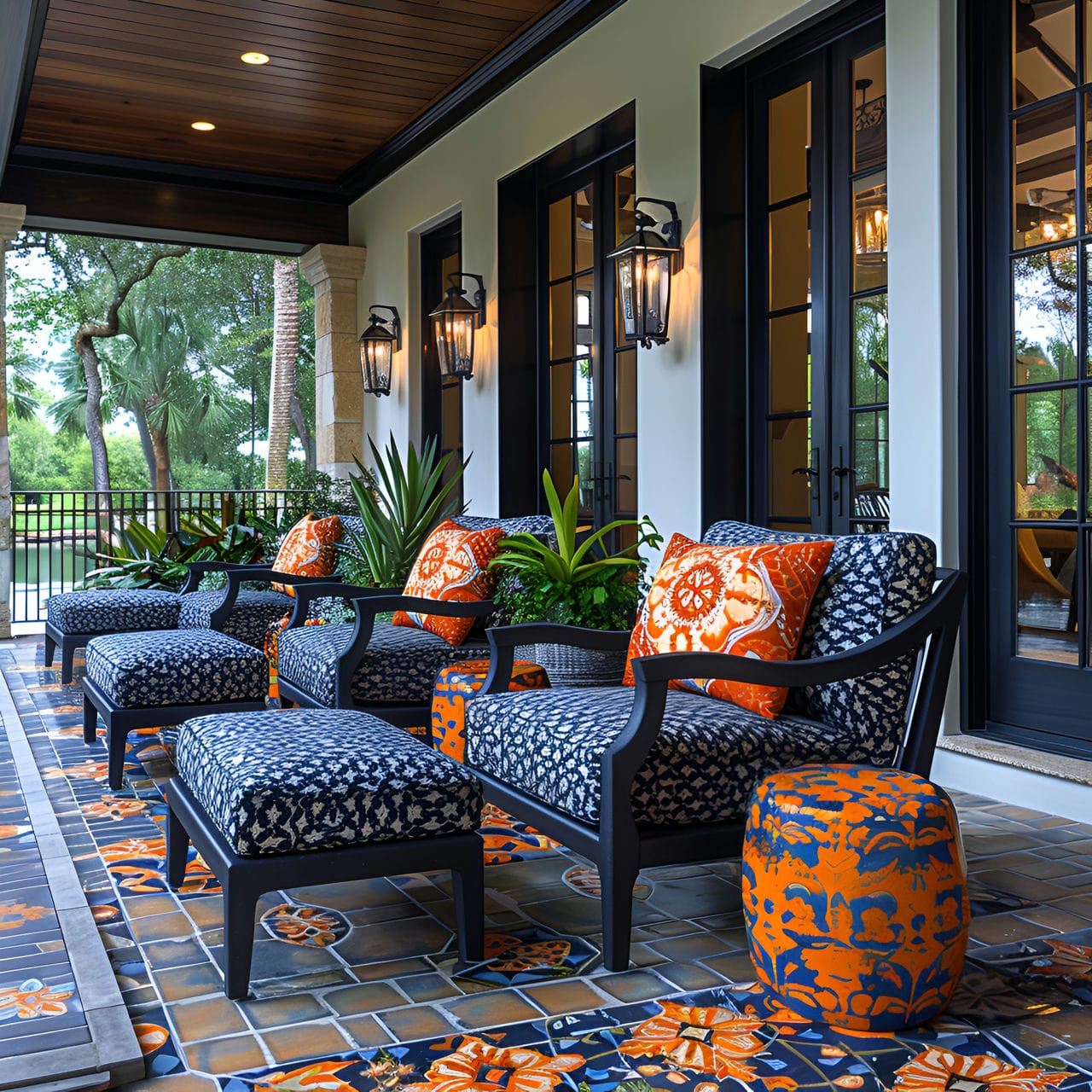
What is the typical shape of a lanai?
The typical shape of a lanai is a rectangular or square footprint for spatial efficiency while still feeling open-air. Rectangular lanais have the longest walls spanning from approximately 13 feet (4 meters) to 26 feet (8 meters) facing scenic views, with narrow ends ranging from approximately 8 feet (2.5 meters) to 13 feet (4 meters) deep on opposite sides. Centered openings connect the transitional outdoor room to interior living spaces. Square lanais ranging from approximately 50 square feet (4 square meters) to 100 square feet (8 square meters) concentrate stair descent under an open sky while maintaining equal furniture clearance. Contemporary lanais using retractable screens blur strict divisions between interior domains. Standard attached lanais adopt pragmatic rectangular or balanced square floor plans from approximately 50 square feet (4 square meters) to 100 square feet (8 square meters) to balance enveloping natural atmosphere with practical ornamental garden navigation or seating arrangements.
What furniture commonly equips a lanai?
Listed below are the types of furniture commonly equip a lanai:
- Outdoor sofas: Outdoor sofas are a fundamental piece of furniture in a lanai, designed for comfort and socializing. Cushions covered in weather-resistant fabric add comfort and aesthetic appeal. These sofas create inviting seating areas, perfect for relaxation or entertaining guests.
- Dining sets: Dining sets in a lanai are essential for outdoor meals and gatherings. These sets consist of a table and matching chairs made from materials like wrought iron, aluminum, or weather-resistant wood. Dining furniture in a lanai enhances the functionality of the space, often accompanied by umbrellas or pergolas for shade.
- Chaise lounges: Chaise lounges in a lanai offer relaxation and sunbathing spots. Made from materials like all-weather wicker, metal, or wood, they come with comfortable, weather-resistant cushions. These furniture provide a resort-like feel, ideal for leisure or poolside relaxation.
- Coffee tables: Coffee tables in a lanai are crucial for functionality, serving as a convenient surface for drinks, books, or decorative items. Constructed from durable materials like glass, metal, or treated wood, this furniture withstands outdoor elements.
- Side tables: Side tables in a lanai provide additional surface space and convenience. Made from weather-resistant materials, they’re designed to complement the primary seating furniture. This furniture is versatile, perfect for holding beverages, plants, or personal items, and can be easily moved as needed.
- Swings or hammocks: Swings or hammocks in a lanai add a playful and relaxing element. This furniture, made from durable fabrics and materials, offers a lounging experience.
- Storage benches: Storage benches in a lanai combine seating with practical storage. Constructed from weather-resistant materials, this furniture provides a space to store cushions, gardening tools, or entertainment supplies.
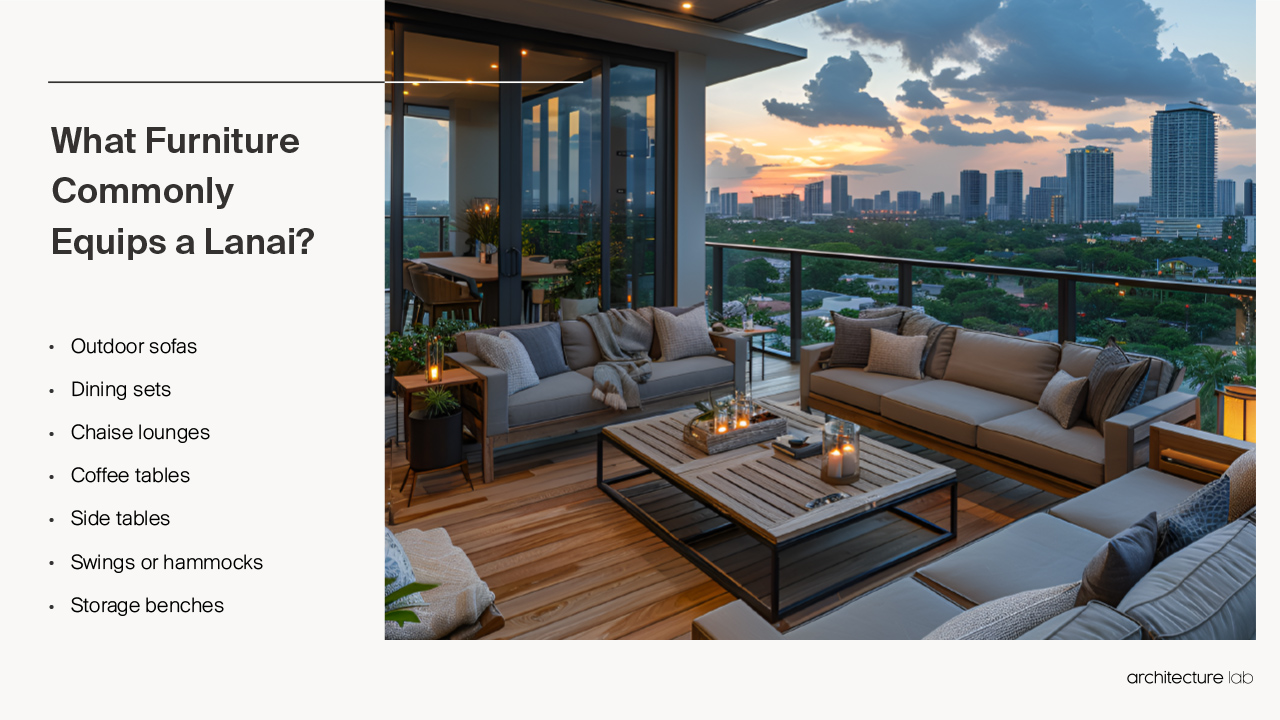
What is the normal ceiling height of a lanai?
The normal ceiling height of a lanai is approximately 8 feet (2.4 square meters) to 9 feet (2.7 square meters). Average heights allow typical clearance for lighting fixtures and ceiling fans without infringing on headroom for furnishings below. Contemporary lanais may incorporate exposed beam architecture from approximately 8.2 feet (2.5 square meters) to 9.8 feet (3 square meters), providing a generous sense of airflow and volume. Smaller footprint lanais under approximately 172 square feet (16 square meters) feel confined by ceilings exceeding 9 feet (2.7 square meters). Luxury lanais elevate architectural details with heights up to approximately 14.8 feet (4.5 square meters). Proper lanai ceiling height considers sheltering open-air occupants below while allowing eye lines to appreciate the surrounding environmental beauty.
What colors are lanai rooms usually painted?
Listed below are the colors usually used in lanai rooms painted:
- Blue: lanai rooms often feature blue due to its association with the ocean and sky. Common shades include navy, cerulean, and turquoise. These colors are practical for creating a thematic alignment with the natural surroundings. Lighter blues are used to enhance the sense of space, while darker tones provide a contrast.
- White: White is a standard color for lanai rooms, offering a clean and neutral background. It ranges from pure white to soft ivory. This color is chosen for its ability to reflect light, making rooms appear brighter and more spacious.
- Green: Green is used in lanai rooms to mirror the lush vegetation of the environment. Shades like mint, emerald, and seafoam are prevalent. Darker greens are often used for accent walls or décor.
- Beige: Beige is a common choice for lanai rooms, providing a warm and inviting atmosphere. Variants range from light sandy tones to richer taupe. Beige is a color that is preferred for its ability to blend with other elements in the room.
- Yellow: Yellow, especially in softer shades like lemon or buttercream, is used in lanai rooms. This color is chosen for its bright qualities, evoking a sense of sunshine. It works well with other colors and often creates a focal point or accent.
- Coral: Coral, a blend of pink and orange, is popular in lanai rooms. It’s selected for its warm, tropical feel reminiscent of island sunsets. Coral can range from soft pastel to a more vivid hue, offering versatility in design.
- Gray: Gray is increasingly popular in lanai rooms, offering a contemporary and sophisticated look. Shades vary from light silver to deep charcoal. Gray is a practical choice as a neutral backdrop that pairs well with various accent colors.
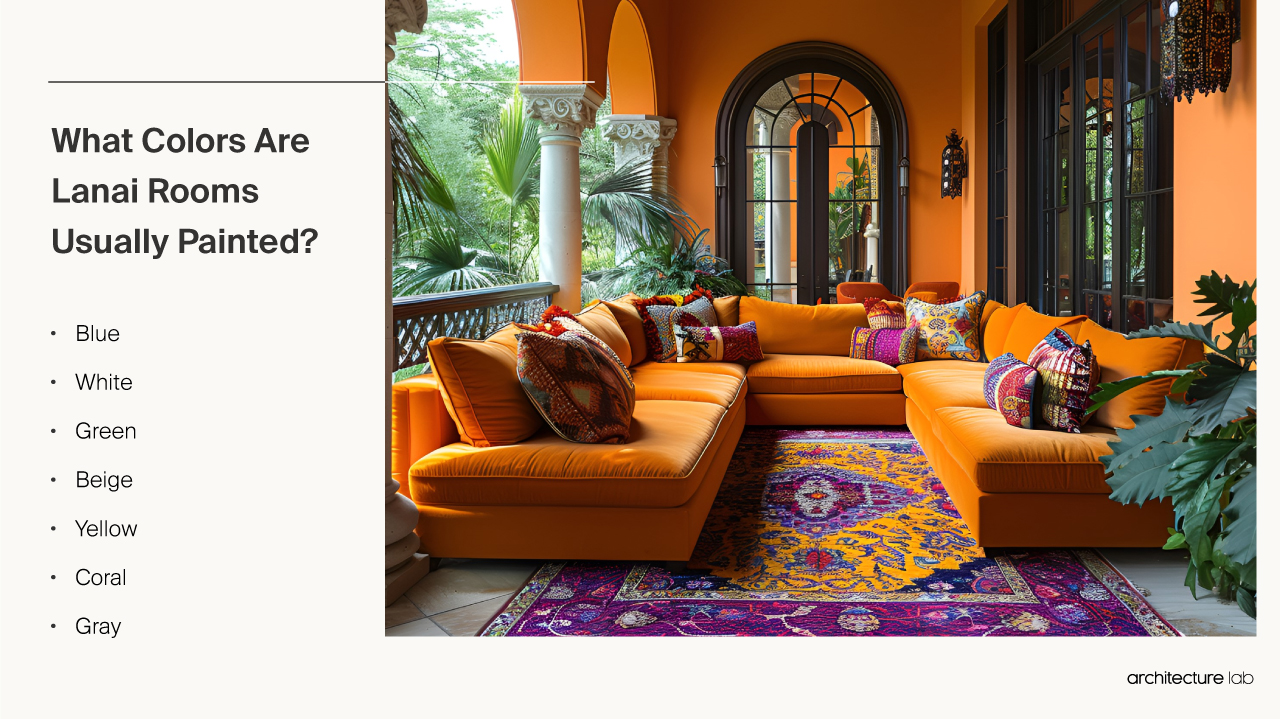
What makes the lanai functional?
The lanai is functional with weather protection, indoor-outdoor transitional space, flexible room uses, scenic settings, and customization. Firstly, a lanai provides weather protection while allowing outdoor views and airflow. The screens or windows keep out insects, debris, rain, etc., while the roof shields occupants from the sun and other elements. Secondly, a lanai is an outdoor living space that extends the indoor rooms for relaxation, dining, entertaining guests, or other activities. Thirdly, a lanai adds flexible square footage, increasing usable space for gatherings, hobbies, work, etc. It is more affordable than a sunroom addition but still raises property value. Fourthly, careful lanai placement captures scenic outdoor views as part of the appeal. Positioning it to overlook gardens, pools, or other pleasing sights makes it more enjoyable. Lastly, lanai customization suits owners’ needs and preferences. Enclosure, roofing, and furnishing choices allow personalized styling for the optimal experience.
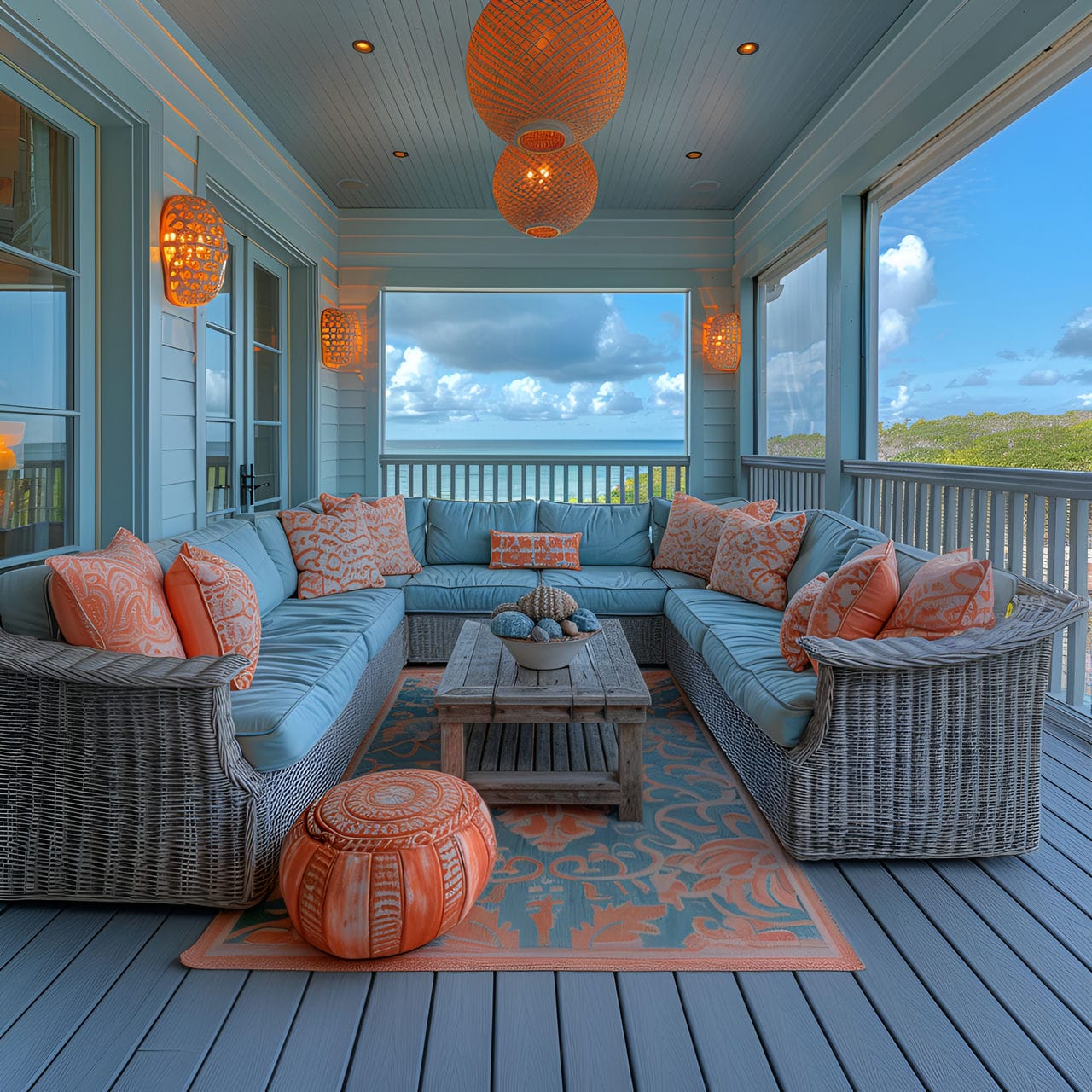
How is energy efficiency achieved in a lanai?
Energy efficiency is achieved in Lanai through proper insulation and glazing, automated climate control integration, hydroponic growing systems, and eco-friendly design and construction. Firstly, energy efficiency can be improved in a greenhouse lanai through proper insulation and glazing. Using thicker glass panels with vinyl or insulated trim improves insulation and energy retention. Combining double-pane glass, argon gas, and low-emissivity coatings enhances energy efficiency significantly. Secondly, installing energy-efficient LED lighting systems reduces electricity usage while providing sufficient illumination. Smart lighting systems with timers, dimmers, and motion sensors improve efficiency. Thirdly, automated climate control systems help maintain optimal temperatures. Motorized windows, shades, and ventilation allow better control over natural lighting, heat, and airflow. Lastly, hydroponic growing systems consume less water and energy than soil-based planting. The enclosed greenhouse environment also protects crops from pests and diseases, eliminating the need for pesticides.
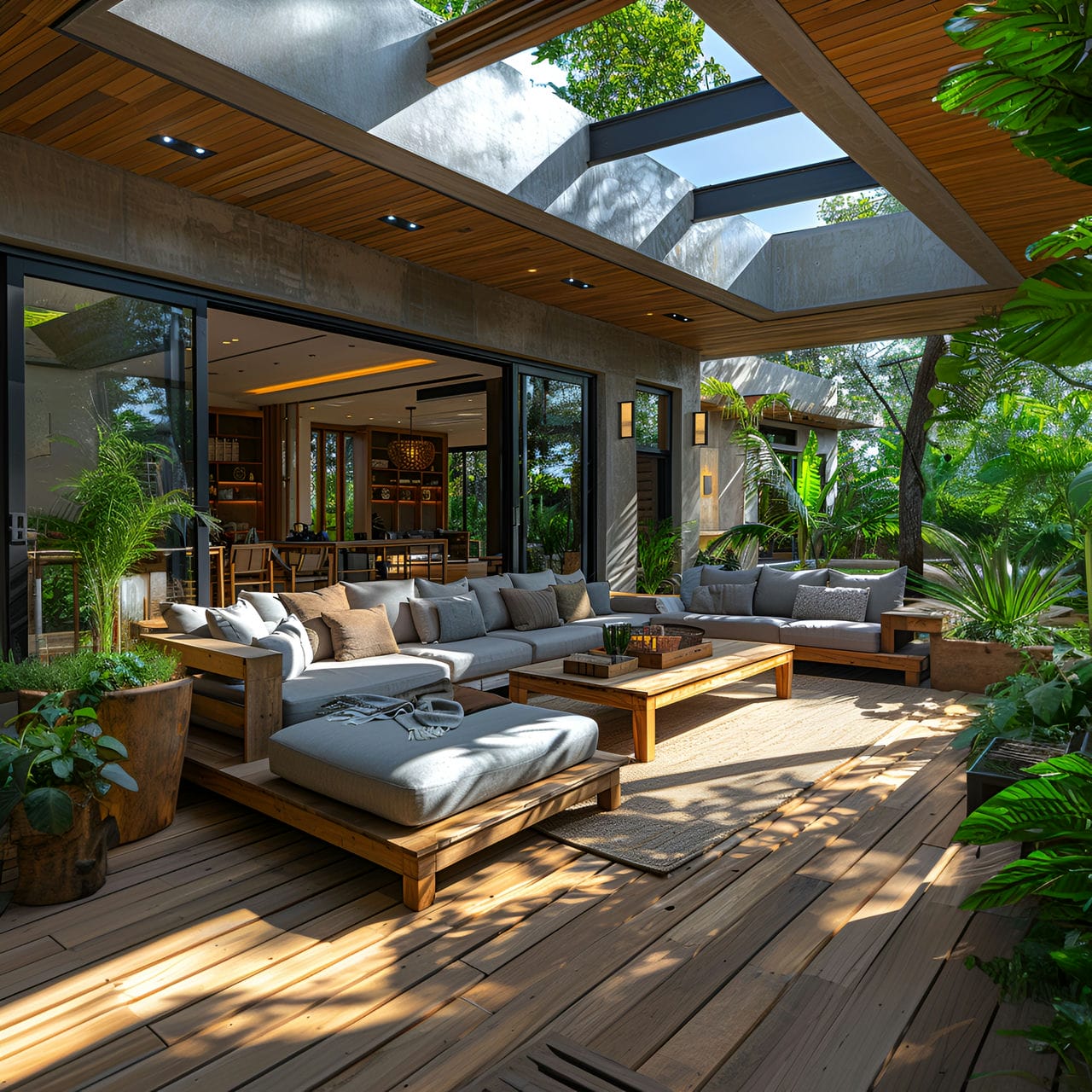
How much does it typically cost to renovate a lanai?
The average cost to renovate or expand an existing residential lanai ranging from approximately 175 square feet (16 square meters) to 260 square feet (24 square meters) falls between $2,000 (€1,800, £1,500) to $10,000 (€9,000, £7,600). Cosmetic updates like fresh neutral paint, staining on connected exterior walls, or new lighting components run closer to $2,000 (€1,800, £1,500). Structural changes like altering the layouts, foundation upgrades for hot tubs/pools, or weatherproofing for outdoor appliances require contractors to drive prices toward $10,000 (€9,000, £7,600). Premium stone or tile upgrades also average $3,000 (€2,700, £2,300). Any additional electrical or sconce lighting enhancements range from $1,500 (€1,350, £1,150) to $3,000 (€2,700, £2,300). For contemporary covered lanais with retractable canopy screens integrated into the architecture, built-in cabinetry, or accessories like fireplaces, costs reach $15,000 (€13,500, £11,400). Typical lanai refresh budgets range from $2,000 (€1,800, £1,500) to $10,000 (€9,000, £7,600). Massive custom overbuilds with designer landscape architecture and integrations would exponentially increase budgets past $20,000+ (€18,000+ £15,000+).
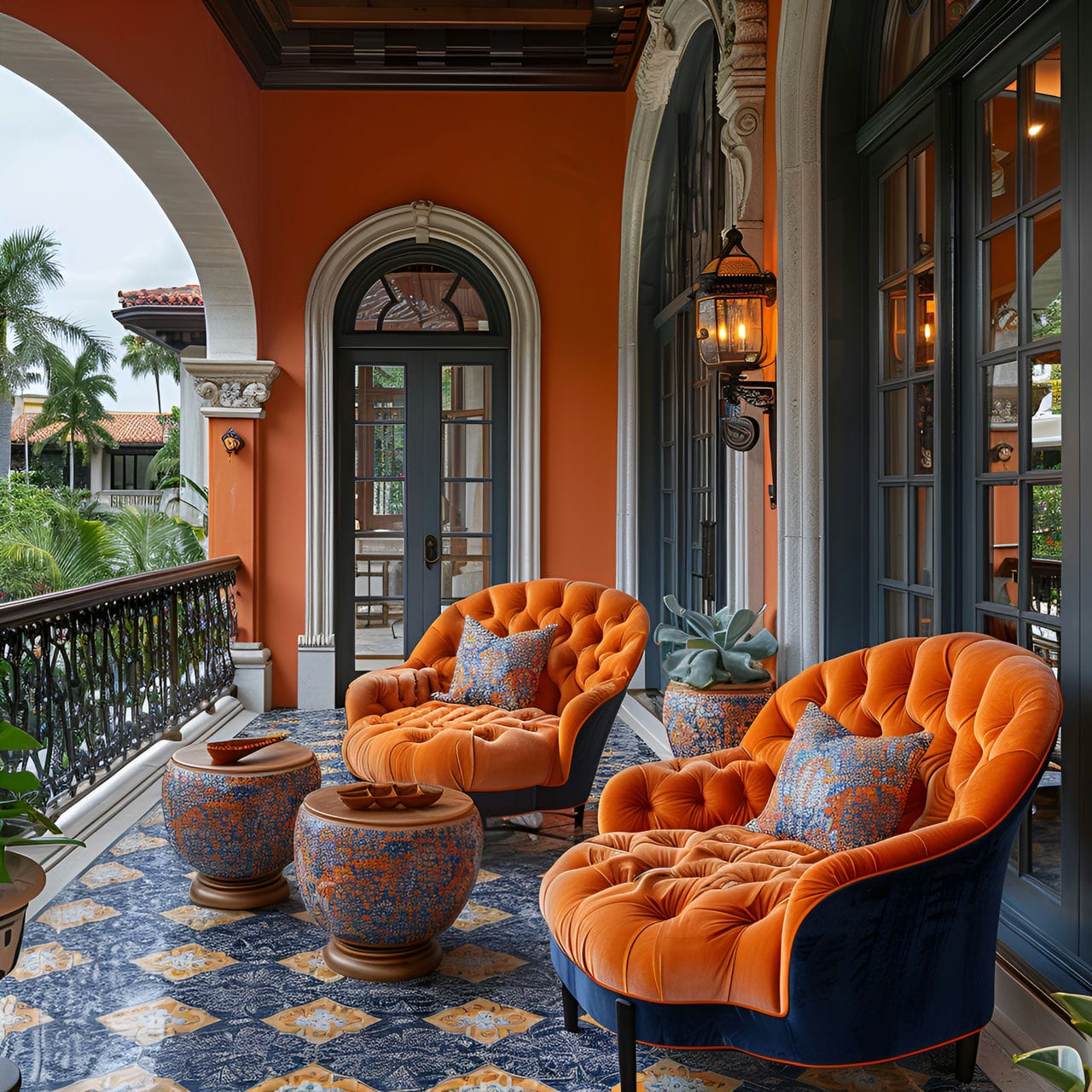
What factors affect the lanai renovation?
Listed below are the factors that affect the lanai renovation:
- Size and layout: The size and layout of a lanai affect renovation decisions. Larger lanais offer more space for elaborate designs and features, while smaller ones require more efficient use of space. The existing layout determines the extent of structural changes possible, such as adding or removing walls, extending the area, or altering the floor plan.
- Materials and construction quality: The choice of materials and construction quality are crucial in lanai renovations. Durable, weather-resistant materials like teak, aluminum, or all-weather wicker are ideal for withstanding outdoor elements. The quality of construction determines the longevity and maintenance requirements of the lanai.
- Style and design preferences: Style and design preferences greatly influence the lanai’s renovation. Choices range from modern and minimalist to traditional and tropical themes. Personal taste dictates the selection of furniture, color schemes, and décor.
- Location and climate: The location and climate of a lanai are critical factors in renovation planning. Areas with harsh weather conditions require materials and designs that withstand extreme temperatures, humidity, or salt air.
- Privacy and security needs: Privacy and security needs are important in lanai renovations. Security measures, such as sturdy locks, alarm systems, or surveillance cameras, might be necessary, depending on the lanai’s accessibility and location.
- Functionality and usage: A lanai’s intended functionality and usage shape its renovation. A lanai designed for dining and entertaining might include a kitchen or bar area, while one for relaxation might focus on comfortable seating and ambient lighting.
- Budget and financial constraints: The budget and financial constraints play a significant role in the lanai’s renovation. A higher budget allows for more extensive changes and high-end materials, while a limited budget might require prioritizing essential improvements and cost-effective solutions.
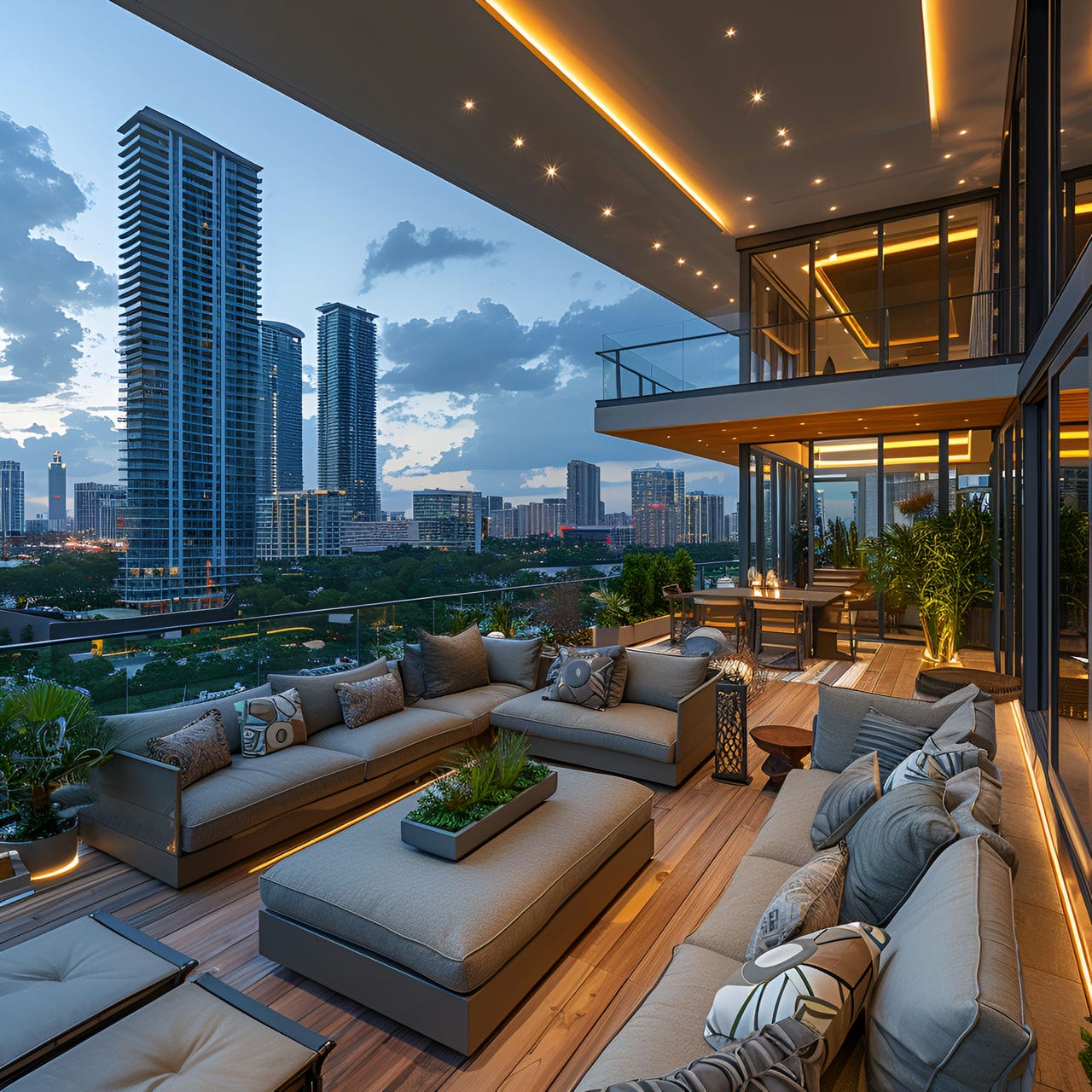
Is an architect required to renovate a lanai?
No, an architect is not required to renovate a lanai, but it is highly advised to hire one. An architect brings invaluable expertise and insight to the project, ensuring that the renovation is aesthetically pleasing but also functional and efficient. Their knowledge of design, space optimization, and material selection is crucial, especially in tailoring the lanai to suit specific lifestyles and preferences. Architects are adept at creating seamless transitions between indoor and outdoor spaces, enhancing the cohesiveness of the design. Their involvement can prevent costly mistakes and oversights, as they can foresee potential challenges and provide solutions.
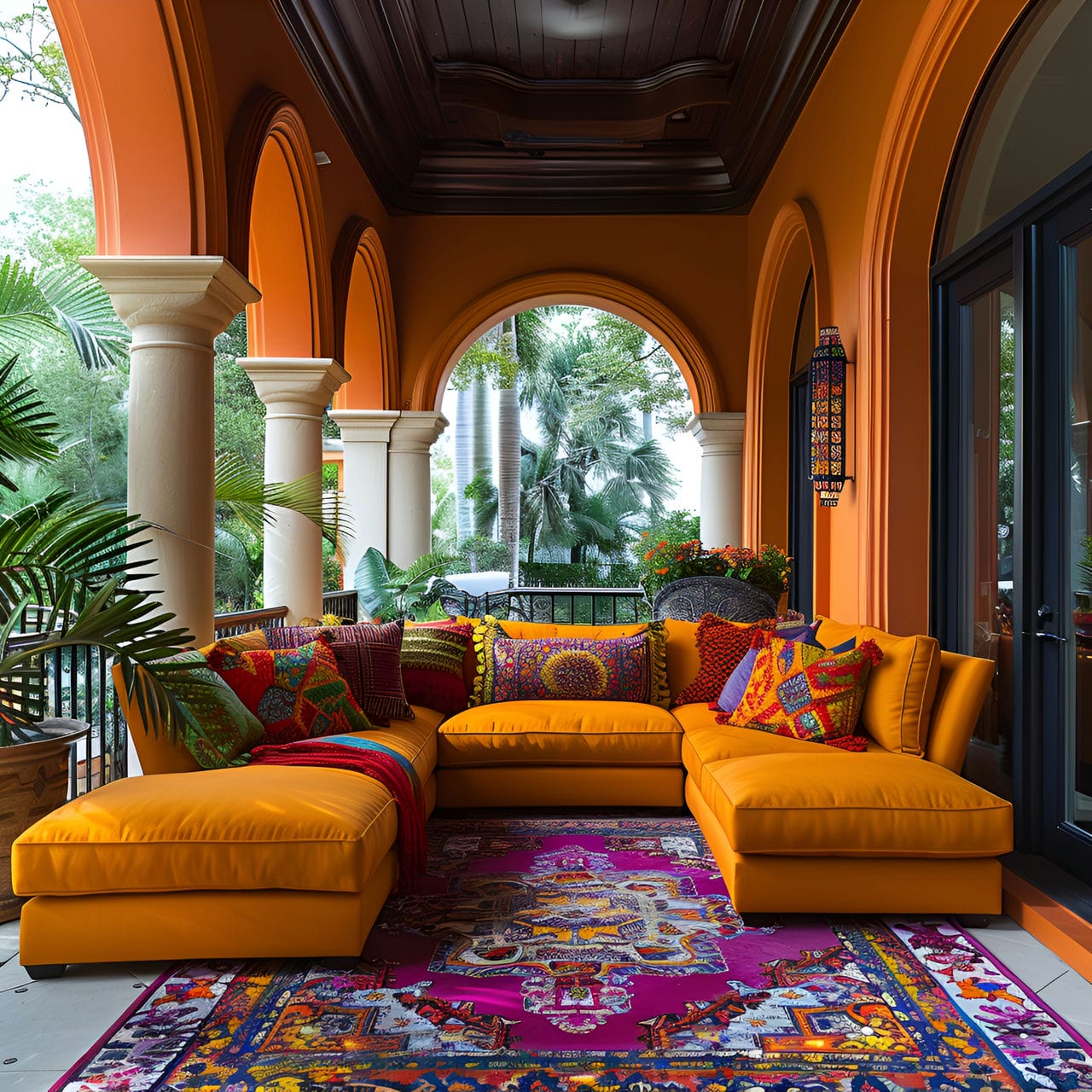
How can an architect help you upgrade a lanai?
Listed below are the ways that an architect can help an owner upgrade a lanai:
- Design optimization: An architect can optimize the design of a lanai, enhancing its functionality and aesthetic appeal. This process includes the thoughtful placement of furniture, the creation of distinct zones for dining and relaxation, and the integration of natural elements.
- Material selection: An architect can provide expert guidance when selecting appropriate materials for a lanai. They can recommend durable, weather-resistant materials that suit the local climate while aligning with the homeowner’s style preferences.
- Lighting and ambiance: Creating the right ambiance through lighting is a key aspect of lanai design, and an architect can offer creative solutions. They can design a lighting plan that highlights architectural features, provides functionality, and creates a warm atmosphere.
- Integration with the home: An architect ensures integration of the lanai with the rest of the home. This integration involves considering the house’s architectural style and providing the lanai complements it.
- Sustainability and efficiency: Architects can incorporate sustainability and efficiency into lanai designs. This might involve using eco-friendly materials, designing for natural ventilation to reduce energy usage, or integrating solar-powered lighting.
- Permits and regulations: Navigating permits and regulations is a complex aspect of lanai upgrades, and an architect can manage this process. They understand local zoning laws, building codes, and permit requirements, ensuring the renovation complies with all regulations.
- Project management: An architect can provide comprehensive project management for lanai upgrades. This role includes coordinating with contractors, overseeing construction, and ensuring quality control.
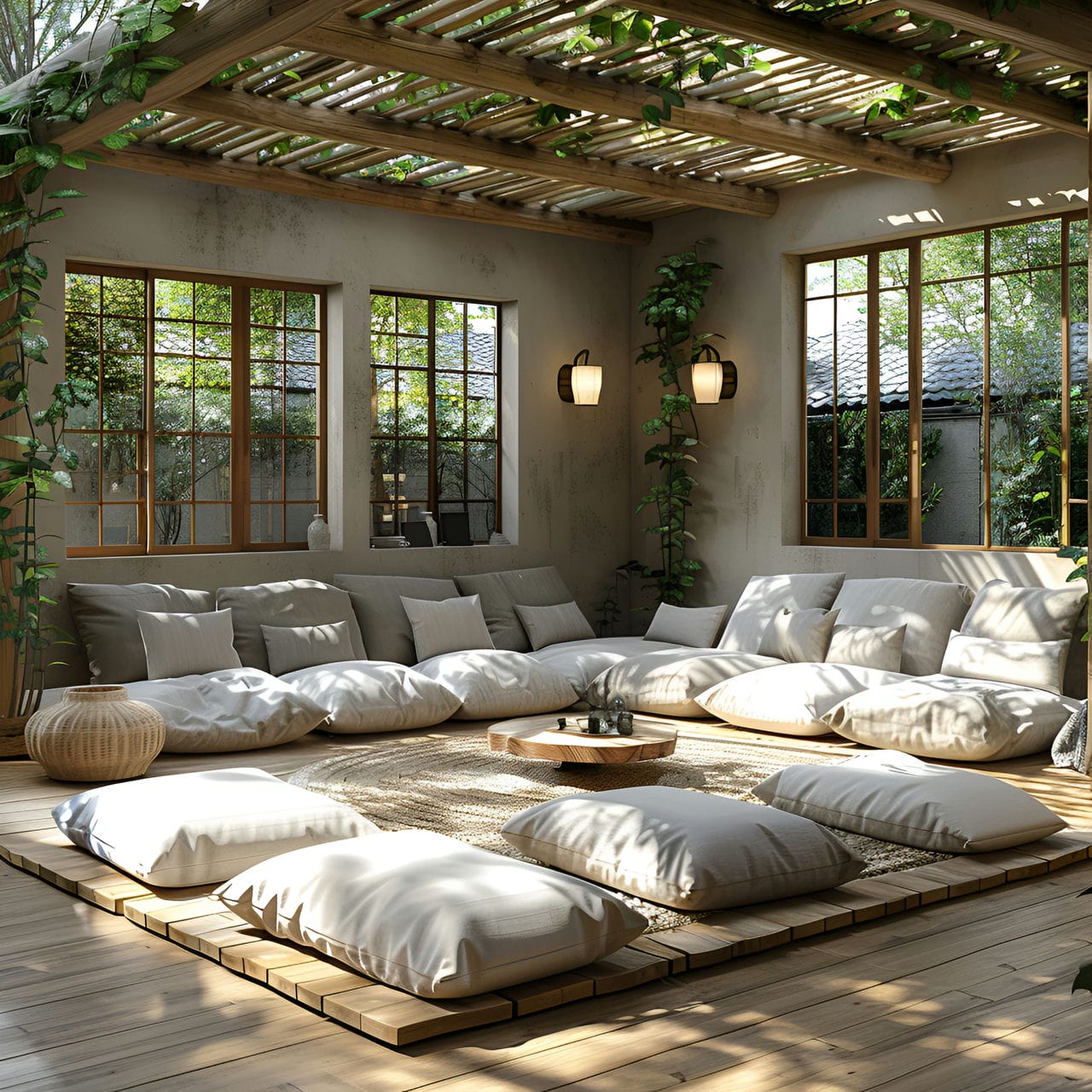
How much does it cost to hire an architect to renovate a lanai?
The average cost to hire an architect to design a residential lanai renovation ranges from $1,500 (€1,350, £1,150) to $5,000 (€4,500, £3,800) based on the scale and customization involved. Most architects charge between $100 (€90, £75) to $175 (€155, £135) per hour. Adjusting a 175 square foot (16 square meters) lanai with new lightweight drapery screens and repainted walls may take 8-12 hours for fees of approximately $1,500 (€1,350, £1,150). Enhancing a 260 square foot (24 square meters) outdoor living space through minor layout changes like added stair width, privacy vegetation barriers, or hanging bed nooks requires closer to 15-25 architectural hours averaging approximately $2,500 (€2,250, £1,900). Top-tier landscape designers incorporating fully integrated indoor/outdoor architecture using collapsible NanaWall glass systems, cantilevered open-air spas amidst tiered garden water features, electronic privacy partitions, and signature masonry fireplace centerpieces often charge $5,000 (€4,500, £3,800) or more given elaborate engineering coordination over 40-60 hours. Typical lanai improvement concepts run $1,500 (€1,350, £1,150) to $2,500 (€2,250, £1,900), while extensive layout redesigns allowing seamless living room extensions match customization investments between $2,500 (€2,250, £1,900) to $5,000+ (€4,500+, £3,800+).
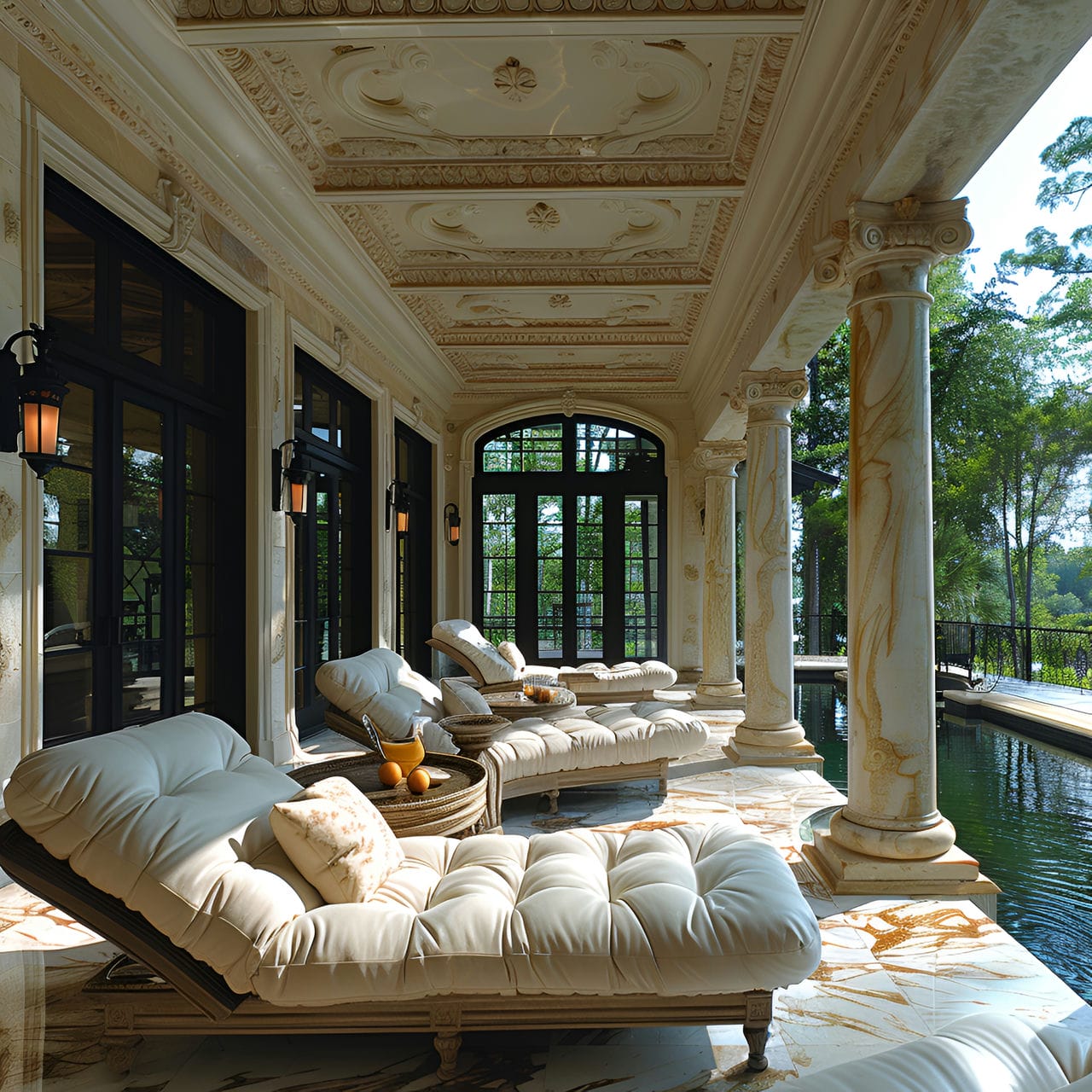
Is it worth it to hire an architect to upgrade a lanai?
Yes, hiring an architect to upgrade a lanai can be worth it. An architect brings specialized expertise in design and planning that goes beyond mere aesthetics. Their knowledge in selecting appropriate materials ensures durability and suitability for the specific climate, which is crucial for outdoor spaces like a lanai. Architects also understand how to create transitions between indoor and outdoor areas, enhancing the living experience and potentially increasing the property’s value. An architect’s involvement can transform a simple lanai upgrade into a well-thought-out home extension, offering increased usability and an aesthetic appeal.
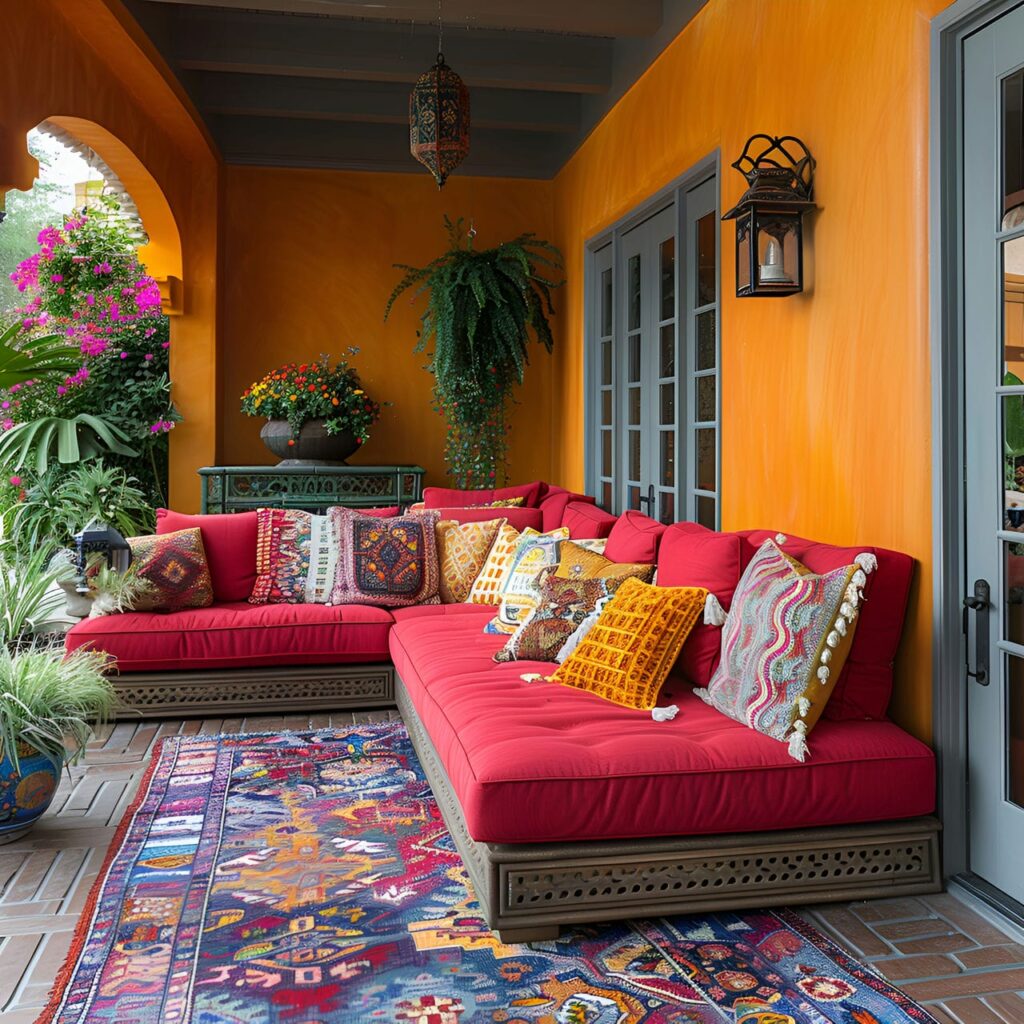
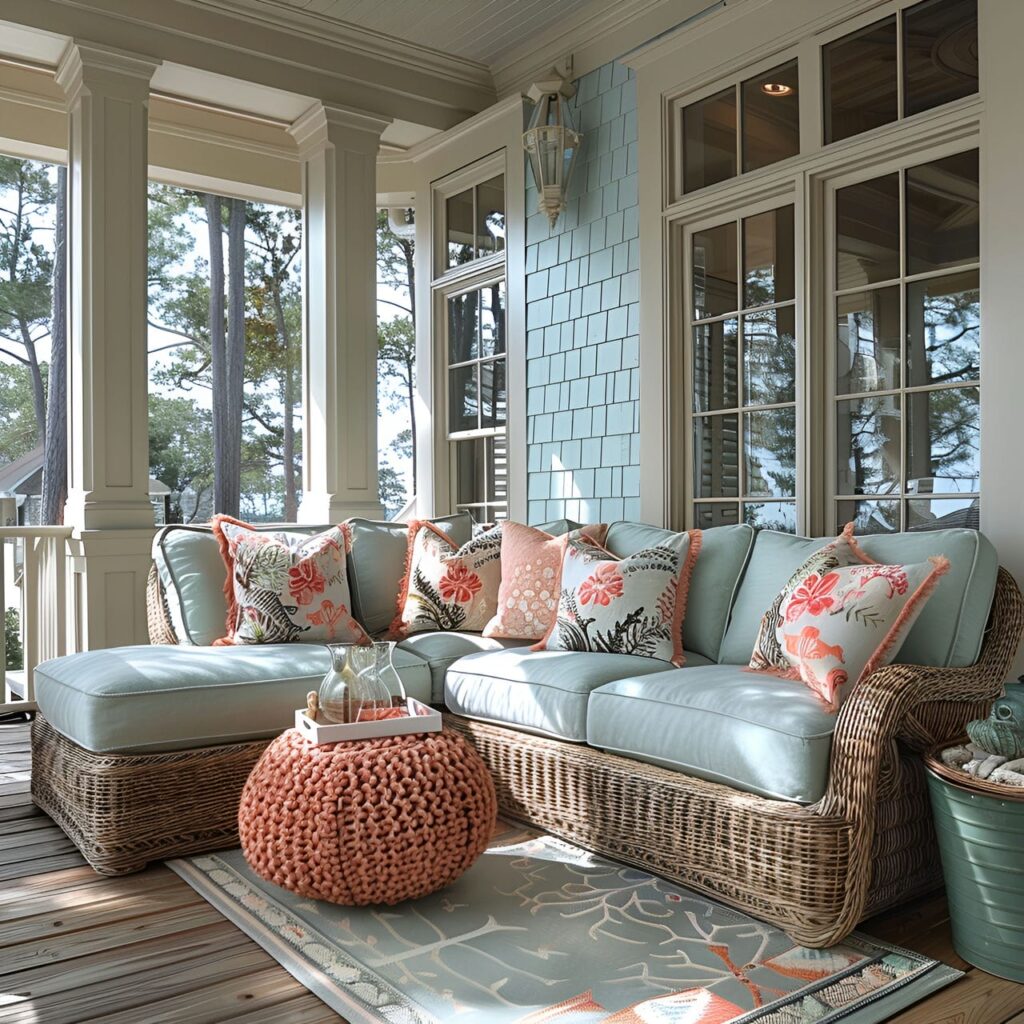
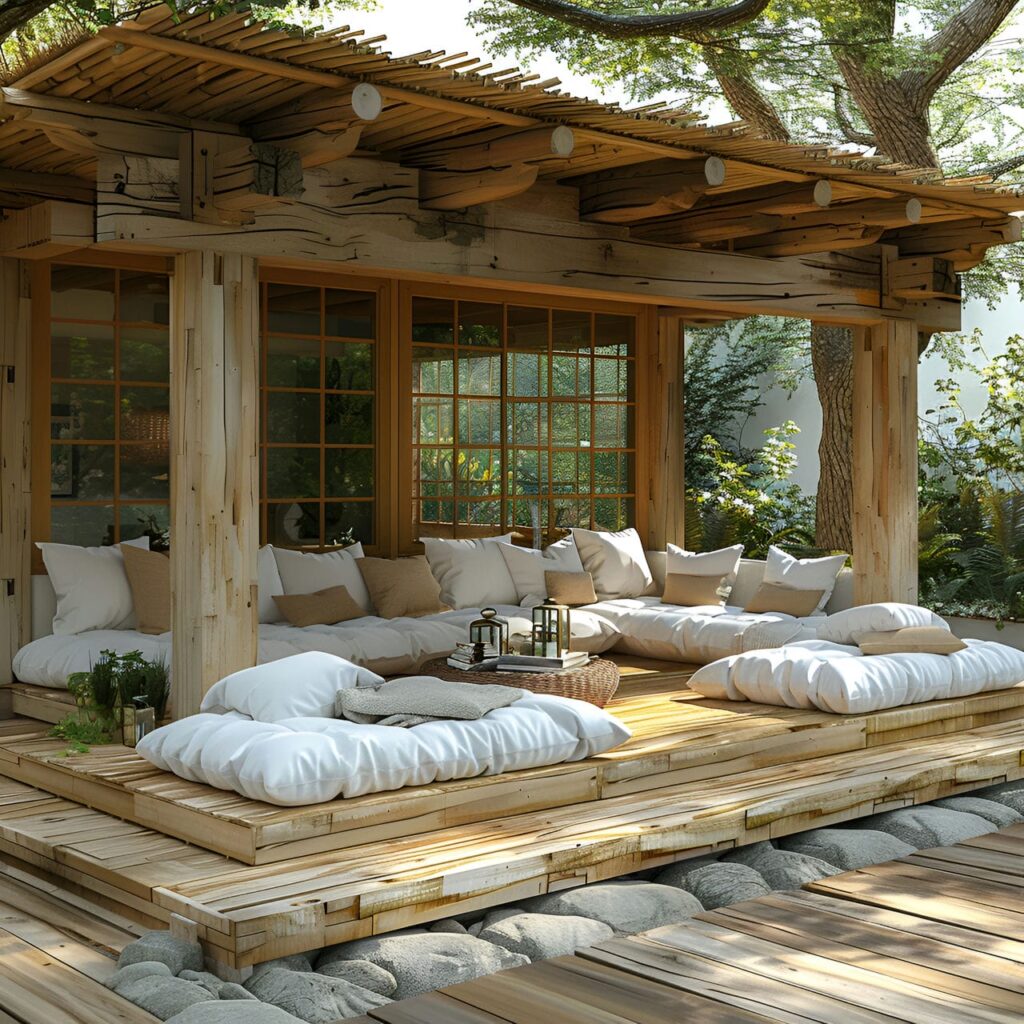
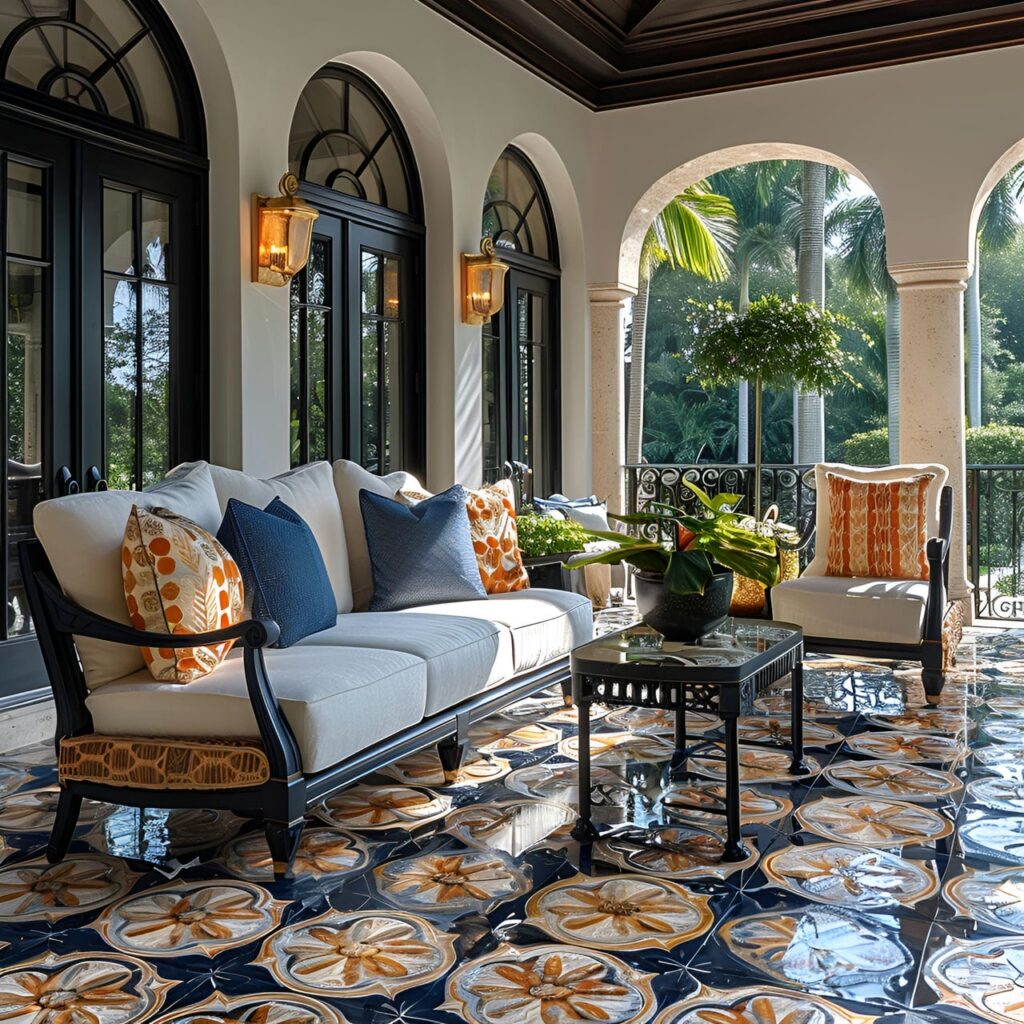
How long is needed to redecorate a lanai?
Redecorating a lanai takes between 2 and 6 weeks. Firstly, the size of the lanai plays a significant role in determining the timeline. A larger space may require more time for redecoration, as it involves more extensive planning and execution. Secondly, simple aesthetic updates like painting or adding new furniture can be completed relatively quickly, while more extensive renovations, such as installing new flooring or building additional structures like pergolas, take longer. Thirdly, the availability and selection of materials and furnishings influence the timeline. Custom elements or materials that need to be ordered can add to the duration, mainly if delivery delays occur. Fourthly, the availability and schedule of contractors or workers play a part. If the redecoration relies on professional help, their current workload and efficiency can affect how quickly the project is completed. Lastly, unforeseen challenges or complications during the redecoration process can extend the timeframe. This could include structural issues discovered during renovation or delays in supply chains.
What are the struggles of the homeowner to redecorate a lanai?
Listed below are the struggles of the homeowner to redecorate a lanai:
- Budget constraints: Homeowners often struggle with budget constraints when redecorating a lanai. Allocating funds for materials, labor, and unexpected expenses can be challenging. They must balance their desire for quality materials and professional work against the available budget.
- Material selection: Selecting suitable materials for a lanai is a common struggle. Homeowners need to consider durability, maintenance, aesthetics, and climate suitability. The choices can be overwhelming, and making the wrong selection can lead to increased maintenance or premature replacements, adding to long-term costs.
- Design choices: Making design choices that balance functionality and style is a significant struggle. Homeowners often find it challenging to create a cohesive look that complements their home’s architecture while also serving their practical needs for the space, such as dining, relaxation, or entertainment.
- Weather considerations: Weather considerations impact the redecoration of a lanai. Homeowners must select materials and design elements that withstand local weather, intense sun, rain, or humidity.
- Space optimization: Optimizing space in a lanai is a common challenge. Homeowners must plan the layout effectively to accommodate various activities while ensuring the space isn’t crowded or underutilized.
- Contractor coordination: Coordinating with contractors can be a struggle during lanai redecoration. Ensuring contractors understand the vision, adhere to the schedule, and stay within budget requires constant communication and supervision.
- Compliance with regulations: Navigating building codes and regulations can be difficult for homeowners. Ensuring that the lanai redecoration complies with local zoning laws and building codes requires a thorough understanding of legal requirements.
